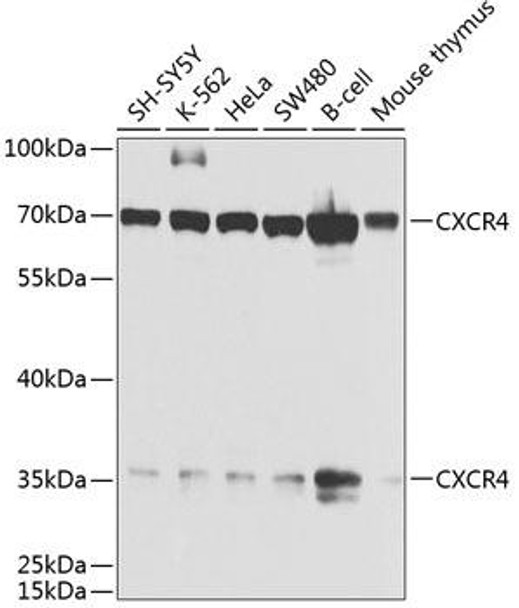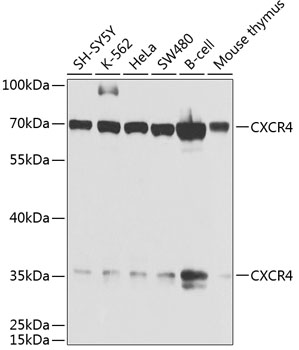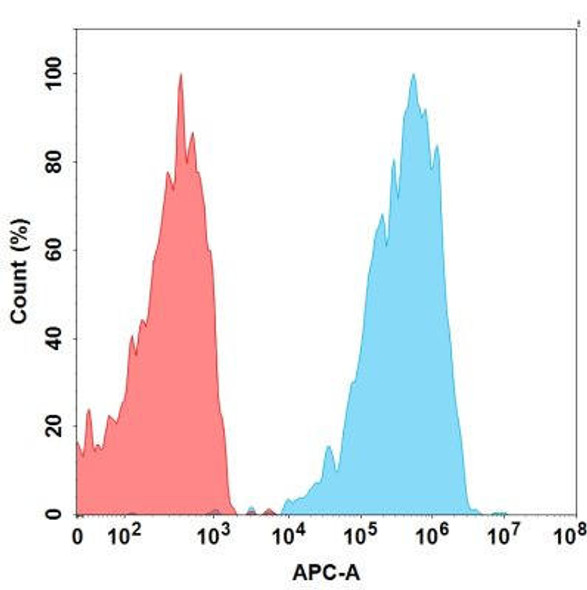Immunology Antibodies 1
Anti-CXCR4 Antibody (CAB1303)
- SKU:
- CAB1303
- Product Type:
- Antibody
- Reactivity:
- Human
- Reactivity:
- Mouse
- Host Species:
- Rabbit
- Isotype:
- IgG
- Antibody Type:
- Polyclonal Antibody
- Research Area:
- Immunology
Description
| Antibody Name: | Anti-CXCR4 Antibody |
| Antibody SKU: | CAB1303 |
| Antibody Size: | 20uL, 50uL, 100uL |
| Application: | WB |
| Reactivity: | Human, Mouse |
| Host Species: | Rabbit |
| Immunogen: | A synthetic peptide corresponding to a sequence within amino acids 1-100 of human CXCR4 (NP_003458.1). |
| Application: | WB |
| Recommended Dilution: | WB 1:500 - 1:1000 |
| Reactivity: | Human, Mouse |
| Positive Samples: | SH-SY5Y, K-562, HeLa, SW480, B-cell, Mouse thymus |
| Immunogen: | A synthetic peptide corresponding to a sequence within amino acids 1-100 of human CXCR4 (NP_003458.1). |
| Purification Method: | Affinity purification |
| Storage Buffer: | Store at -20'C. Avoid freeze / thaw cycles. Buffer: PBS with 0.02% sodium azide, 50% glycerol, pH7.3. |
| Isotype: | IgG |
| Sequence: | MEGI SIYT SDNY TEEM GSGD YDSM KEPC FREE NANF NKIF LPTI YSII FLTG IVGN GLVI LVMG YQKK LRSM TDKY RLHL SVAD LLFV ITLP FWAV DAVA |
| Gene ID: | 7852 |
| Uniprot: | P61073 |
| Cellular Location: | Cell junction, Cell membrane, Early endosome, Late endosome, Lysosome, Multi-pass membrane protein |
| Calculated MW: | 39kDa/40kDa |
| Observed MW: | 36kDa/70kDa |
| Synonyms: | CD184, D2S201E, FB22, HM89, HSY3RR, LAP-3, LAP3, LCR1, LESTR, NPY3R, NPYR, NPYRL, NPYY3R, WHIM, WHIMS, CXCR4 |
| Background: | This gene encodes a CXC chemokine receptor specific for stromal cell-derived factor-1. The protein has 7 transmembrane regions and is located on the cell surface. It acts with the CD4 protein to support HIV entry into cells and is also highly expressed in breast cancer cells. Mutations in this gene have been associated with WHIM (warts, hypogammaglobulinemia, infections, and myelokathexis) syndrome. Alternate transcriptional splice variants, encoding different isoforms, have been characterized. |
| UniProt Protein Function: | CXCR4: Receptor for the C-X-C chemokine CXCL12/SDF-1 that transduces a signal by increasing intracellular calcium ion levels and enhancing MAPK1/MAPK3 activation. Acts as a receptor for extracellular ubiquitin; leading to enhanced intracellular calcium ions and reduced cellular cAMP levels. Involved in hematopoiesis and in cardiac ventricular septum formation. Also plays an essential role in vascularization of the gastrointestinal tract, probably by regulating vascular branching and/or remodeling processes in endothelial cells. Involved in cerebellar development. In the CNS, could mediate hippocampal-neuron survival. Acts as a coreceptor (CD4 being the primary receptor) for HIV-1 X4 isolates and as a primary receptor for some HIV-2 isolates. Promotes Env-mediated fusion of the virus. Monomer. Can form dimers. Interacts with CD164. Interacts with HIV-1 surface protein gp120 and Tat. Interacts with ARRB2; the interaction is dependent on the C-terminal phosphorylation of CXCR4 and allows activation of MAPK1 and MAPK3. Interacts with ARRC; the interaction is dependent on the C-terminal phosphorylation of CXCR4 and modulates calcium mobilization. Interacts (via the cytoplasmic C-terminal) with ITCH (via the WW domains I and II); the interaction, enhanced by CXCL12, ubiquitinates CXCR4 and leads to its degradation. Interacts with extracellular ubiquitin. Interacts with human cytomegalovirus/HHV- 5 protein UL78. Expressed in numerous tissues, such as peripheral blood leukocytes, spleen, thymus, spinal cord, heart, placenta, lung, liver, skeletal muscle, kidney, pancreas, cerebellum, cerebral cortex and medulla (in microglia as well as in astrocytes), brain microvascular, coronary artery and umbilical cord endothelial cells. Isoform 1 is predominant in all tissues tested. Belongs to the G-protein coupled receptor 1 family. 2 isoforms of the human protein are produced by alternative splicing. |
| UniProt Protein Details: | Protein type:Membrane protein, integral; Receptor, GPCR; GPCR, family 1; Membrane protein, multi-pass Chromosomal Location of Human Ortholog: 2q21 Cellular Component: cell surface; lysosome; leading edge; early endosome; cytoplasmic membrane-bound vesicle; integral to membrane; intercellular junction; growth cone; late endosome; cytoplasm; plasma membrane; cytoplasmic vesicle; external side of plasma membrane Molecular Function:G-protein coupled receptor activity; viral receptor activity; ubiquitin binding; protein binding; cytokine binding; ubiquitin protein ligase binding; myosin light chain binding; coreceptor activity; actin binding; C-X-C chemokine receptor activity Biological Process: entry of virus into host cell; regulation of chemotaxis; viral reproduction; activation of MAPK activity; apoptosis; neuron migration; motor axon guidance; regulation of cell migration; germ cell development; T cell proliferation; elevation of cytosolic calcium ion concentration; germ cell migration; dendritic cell chemotaxis; positive regulation of oligodendrocyte differentiation; inflammatory response; neutrophil activation; response to virus; calcium-mediated signaling; patterning of blood vessels; G-protein coupled receptor protein signaling pathway; ameboidal cell migration; myelin maintenance; response to hypoxia; entry into host cell; brain development Disease: Whim Syndrome |
| NCBI Summary: | This gene encodes a CXC chemokine receptor specific for stromal cell-derived factor-1. The protein has 7 transmembrane regions and is located on the cell surface. It acts with the CD4 protein to support HIV entry into cells and is also highly expressed in breast cancer cells. Mutations in this gene have been associated with WHIM (warts, hypogammaglobulinemia, infections, and myelokathexis) syndrome. Alternate transcriptional splice variants, encoding different isoforms, have been characterized. [provided by RefSeq, Jul 2008] |
| UniProt Code: | P61073 |
| NCBI GenInfo Identifier: | 46577576 |
| NCBI Gene ID: | 7852 |
| NCBI Accession: | P61073.1 |
| UniProt Secondary Accession: | P61073,O60835, P30991, P56438, Q53S69, Q9BXA0, Q9UKN2 B2R5N0, |
| UniProt Related Accession: | P61073 |
| Molecular Weight: | 40,221 Da |
| NCBI Full Name: | C-X-C chemokine receptor type 4 |
| NCBI Synonym Full Names: | chemokine (C-X-C motif) receptor 4 |
| NCBI Official Symbol: | CXCR4 |
| NCBI Official Synonym Symbols: | FB22; HM89; LAP3; LCR1; NPYR; WHIM; CD184; LAP-3; LESTR; NPY3R; NPYRL; HSY3RR; NPYY3R; D2S201E |
| NCBI Protein Information: | C-X-C chemokine receptor type 4; fusin; CD184 antigen; SDF-1 receptor; LPS-associated protein 3; neuropeptide Y receptor Y3; seven transmembrane helix receptor; stromal cell-derived factor 1 receptor; lipopolysaccharide-associated protein 3; seven-transmembrane-segment receptor, spleen; leukocyte-derived seven transmembrane domain receptor |
| UniProt Protein Name: | C-X-C chemokine receptor type 4 |
| UniProt Synonym Protein Names: | FB22; Fusin; HM89; LCR1; Leukocyte-derived seven transmembrane domain receptor; LESTR; Lipopolysaccharide-associated protein 3; LAP-3; LPS-associated protein 3; NPYRL; Stromal cell-derived factor 1 receptor; SDF-1 receptor; CD_antigen: CD184 |
| Protein Family: | C-X-C chemokine receptor |
| UniProt Gene Name: | CXCR4 |
| UniProt Entry Name: | CXCR4_HUMAN |







![Anti-Human CXCR4 [12G5] In Vivo Antibody - Low Endotoxin Anti-Human CXCR4 [12G5] In Vivo Antibody - Low Endotoxin](https://cdn11.bigcommerce.com/s-rd6ounxcu2/images/stencil/590x590/products/78966/84148/anti-human-cxcr4-12g5-in-vivo-antibody-low-endotoxin__76386__16949.1706545518.jpg?c=1)